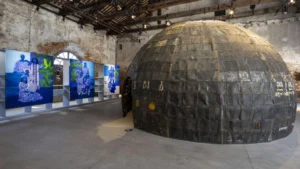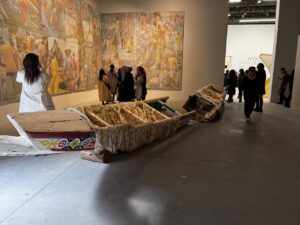Valerie Kabov

Photo Jacopo La Forgia
Venice Biennale is the industry biennale. Unlike its younger siblings around the world, which proudly flaunt their non-commercial bona fides, Venice Biennale is like the eldest tasked or saddled with the responsibility of being the most mainstream, representative and breadwinning. Any doubt about this, quickly disappears with a walk through the Giardini on the vaunted Tuesday first day of the previews, which feels like Art Basel First Choice preview morning if it took place in a garden. The stately public gardens were teeming with the who’s who of the international collectors, museum directors, curators, and other anointed ones, with the demi-monde getting access only from Wednesday.
The Giardini hosts the old world of the biennale establishment and represents to this day the world order somehow still at the turn of the 20th century, with the UK pavilion literally occupying the acme position at the top of the main avenue of the garden, flanked by France and Germany, with Russia and USA in the flanks.
The only African country in the Giardini is Egypt; one can imagine a legacy hire due to the proximate history of the construction of the Suez Canal for European trade and its involvement with Napoleonic and subsequent wars. We are in Venice and these narratives matter even in the 21st century to the self-consciously and precariously enlightened artworld.
Why is any of this relevant to Africa and the participation of African art in the global art world? For lack of a better word ‘it’s the money stupid’. Unlike participation in other mega-exhibitions, inclusion in Venice is still (although arguably less so these days), very strongly correlated with market engagement and career progression for artists, in what is known as ‘the Venice effect’ according to Olav Velthuis.1
For artists coming from art scenes on the so called “periphery’ which outrageously continues to exist and reinforced by Venice in a globalised art world, participation in Venice promises to be an entrance ticket to peerhood accompanied by financial success. Whether that translates into prosperity or sustainability of the local art scenes as represented in the national pavilions is a far more casuistrous proposition, but the lure of Venice remains. For the past fifteen years, since the launch of the controversial African Pavilion as part of Robert Storr’s Biennale in 2007, there has been a concerted push by African advocates to commit African nations to participate in Venice concurrently with curatorial activism by curators appointed to direct the main exhibitions in Giardini and Arsenale to include artists from unfairly underrepresented art scenes in the global conversation in Venice, beefed up by the market.
In this sixtieth edition of the Biennale, African national presence is at its all-time high with thirteen national pavilions with several debuts: South Africa, Ethiopia, Nigeria, Congo, Tanzania, Cameroon, Egypt, Zimbabwe, Benin, Senegal, Cote d’Ivoire, Seychelles, Uganda. However, in many ways, it underscores the fraught nature of national participation in the twenty-first century and twenty-first century art world. Not only does it raise questions about what it means in fact, but equally what does it mean for the art scenes it is intended to represent or include in the Venice-centric version of the global art discourse in the context of the ever-present art market.
Ironies and complications to the straightforward narrative ‘be in it to win it’ sold to the ministries of culture underwriting spilling over across the field. While Benin’s pavilion is a debut, it features Romouald Hazumé a veteran artist with an expansive international career, while in Nigeria’s sophomore pavilion, there is Yinka Shonibare who established his career as a Young British Artist.
Elsewhere too, participation by African and Afro-diasporan artists spans a dramatic spectrum of work and issues from fluidity of identity (self-serving or otherwise) to genuine agency and neo-colonialism. John Akromfha’s representation of Britain, follows his participation in Ghana’s debut pavilion in 2019 a feat no Ghana based artist would be able to achieve, regardless of the merits. And then there is the agency spectrum demonstrated in two non-African pavilions working with African/Afro-diasporan artists; the Netherlands Pavilion’s Renzo Martens’ orchestrated project of making artists out of plantation workers (in a country with a well-established Ecole des Beaux Arts and an incredible artistic tradition), on the other, Kapwani Kiwanga a Canadian artist based in France speaks to the confidence and agency of someone engaging on their own terms.

The range and quality of accomplishments of African pavilion artists, can also be parsed through the prism of the alignment of the artists selected with availability and access to Western capital and channels to market. Ergo Wael Shakwy with two blue chip gallery supports (Lisson Gallery and Lia Rumma) is able to present a stellar vehicle, conversely Seychelles is hatching a fledgling debut in a tiny retreat in Arsenale, which feels both courageous and touchingly optimistic. Symptoms of vulnerability through lack of access to capital, adequate information and opportunity/loopholes in La Biennale’s rules for national pavilions which has created problems of the failed Kenyan and Namibian pavilions in years past, were also evident in this edition, with Tanzania’s ‘debut’ pavilion being organised by an enthusiastic Italian collector, ostensibly from his personal collection. The Cameroonian pavilion with no fewer than fourteen artists, presented more than half of whom seemed to have no connection to the country. The ‘Congo’ pavilion promised a stellar array of the country’s top artists like Aimé Mpane, Steve Bandoma, Kongo Astronauts and Eddy Kamuanga. Viewed across these varying paradigms speaking about Africa in Venice as a block project loses meaning. It does however continue to underscore the dominant role that the Global North exerts and how little in fact shifts in the centre-periphery paradigm of the artworld despite decades of protestation to the contrary.
At a certain point, temporal politics need to fall apart and away and art has a right to be considered as a voice and stake a claim for joy, poignance, clarity and that word we hardly ever use any more in contemporary art ‘poetry’. These rare moments do exist and make for meaningful memories and experience, for which we are all there, cynical, jaded, polarised. It is in those moments that works by artists in the fragile network of African national pavilions do deliver. The eloquent simplicity of the prostrate mega-human carved by Jems Koko Bi in the Ivorian Pavilion, the majestic aglomerative sculpture by Yinka Shonibare in the Nigerian Pavilion; the quiet nuance of Alioune Diagne’s fresco, in fact a painting, framed by a lonely boat installation in Senegal’s pavilion, the captivating glass by Chloe Quenum, which glows in the light despite, not because of all the text and contextualization around the work; the contemplative and poignant sound work and installation by MADEYOULOOK (Molemo Moiloa and Nare Mokgotho) in the South African pavilion; the lovely if conventionally presented Ethiopian Pavilion, a solo painting exhibition by Tesfaye Urgessa, and the symphonies of material narrative abstraction by Moffat Takadiwa, Troy Makaza and Victor Nyakauru in the Zimbabwaean pavilion2. In a year, where Burberry sponsored the British Pavilion and Chanel sponsored the French and the main exhibition attempted to suggest that exceptional standards and spectacular accomplishment are the preserve of those highly capitalised, there is opportunity to think differently. The work of these artists makes a clear assertion that big dreams are not the preserve of the rich, that flights of joy and imagination at the highest level of sophistication are not the unique preserve of Western or Eastern scholarship for that matter, that there are many ways to sing wisdom to paint insight, to weave contemplation.
Meeting the world in Venice is far from optimal. Seeing African art in Venice is not at all ideal. Venice being a meeting point for African and Afro-diasporan artists and art professionals around the world is problematic.3 Trying to change narratives of centre-periphery in a centre is unequivocally absurd. But sometimes art should be allowed to win, even for a minute because it is at the moment it does, that we know that the vaunted ‘canon’ can be made whole and elevated through the experience.
